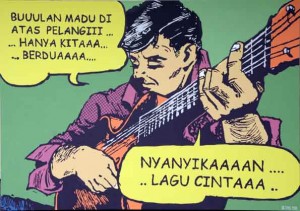
by Yusuf Martin
There is an image refusing to leave my head. It’s of a youth, guitar in hand, kampung serenading. This iconic image, for me, represents all that is Malaysian, the serenity of idyll, the incumbent artistic muse and preponderance to nostalgia.

By Eva McGovern
Arresting in its criticality and positing of the most urgent questions surrounding art production and public engagement, the Jakarta biennale is a much needed respite for jaded art tourists. Its curatorial commitment, as well as sheer production has a stirring potency for multiple audiences. And its strategy to reclaim public spaces and cultural experiences in a city with a of population of 9 million people is without a doubt, a formidable self appointed challenge. Mission statements that look at the local, regional and international through the work of artists under 40, and all with a connection to Southeast Asia makes, for once, makes perfect sense as a remit, both conceptually and in its display
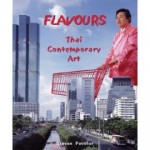
by ARTERI
It is not uncommon for me to be stumped whenever I am asked for a reading list on contemporary art in Southeast Asia. So much of what I know is acquired through fieldwork, contacts, long hours spent talking to artists, curators, historians, critics. So little of this knowledge (gossips, legends, histories, theories) has yet to be documented and written down, analysed and most importantly shared.
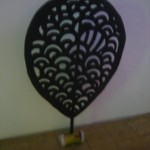
by Simon Soon
On view now in Cemeti Art House, Jogjakarta, is Eko Nugroho’s spell-binding foray into the world of wayang (shadow puppetry), exploring a centuries-old performance medium that functions both as popular entertainment and as a form of culturally sacrosanct art in his ever expanding body of experimentation with different representational formats.
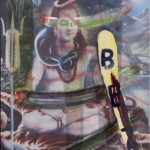
by Tanya Soong
It is possibly one of the art world’s big little ironies that one of the hardest hit country in Southeast Asia by the current economic crisis is playing host to 80s ‘neo-expressionist’ extraordinaire, Julian Schnabel, who led the charge in painting’s postmodern renaissance and whose seemingly soaring fame and ego was neutered by the financial meltdown of ’87.
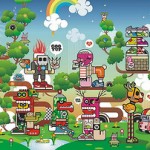
by Simon Soon
Indieguerillas consists of Miko and Santi, a dynamic husband and wife tag team, who operate the label as a design firm/consultancy as well as an artistic collaboration. It’s not entirely true, though, to consider what they do as purely collaborative because an element of combat is central to their creative process, reflecting a practice that pays homages to two different cultural streams – one that is as contemporary as street art and as old as the wayang.
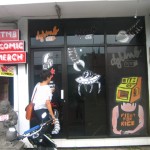
by Simon Soon
Once in awhile, it’s nice and healthy to be reminded how insipidly and painfully middle class KL is. That’s one big reason to travel.

by Zedeck Siew
Behind Australian ape-lover Lisa Roet’s recent In-Sight exhibition are worthy sentiments: generally, that the environment is in bad shape; more specifically, that our simian kin are almost all endangered because of human activity. If you see Roet’s ten orangutan portraits – each sketching a different individual ape that she worked with in the 15 years of her enthusiasm – and are then persuaded to donate to the WWF, that’s cool. Perhaps the works have served their purpose.

by Simon Soon
Lining up against the entrance corridor into the main exhibition space at Cemeti Art House, Yogyakarta, last December is an armed unit of five invisible standing figures, suggested through a skeletal furnishing of their martial disposition by the uniformity of their red helmets, strapped-on rifles and firmly planted boots. They allude to the ‘Lombok Chilli’, royal guards of the Yogya Sultanate who still plays a ceremonial role today, that protects, above all, a distinct sense of pride in the Javanese identity they represent.
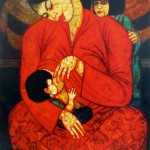
by SHARON CHIN
Chuah Thean Teng passed away on 25 November 2008, just months before the opening of his retrospective at Balai. This makes the viewing of his works especially poignant, above and beyond the sense of nostalgia that runs throughout the show. I felt I was looking at a Malaysia I had never known: I can’t recognize myself in his scenes of pastoral kampung life, and the people he lovingly depicted at work, rest or play are strangers to me.



 | Filed under:
| Filed under: 







